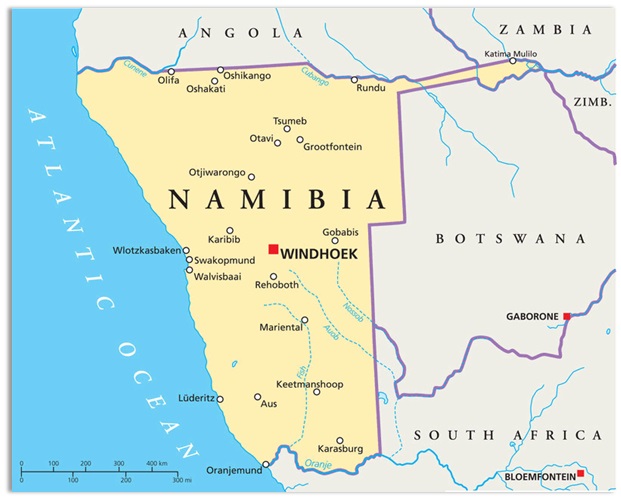About Namibia

General Information |
|
| Population | 2.5 Million (es. 2017) |
| Capital | Windhoek |
| Population density in 2017 (per square kilometre) | 3.1 (2nd least densly populated country in the world after Mongolia) |
| Regions | 14 |
| Zambezi, Kavango East, Kavango West, Kunene, Omusati, Ohangwena, Oshana, Oshikoto, Omaheke. Otjozondjupa, Erongo, Khomas, Hardap, !Karas | |
| Neighbouring Countries | Angola, Botswana, South Africa, Zambia |
| Government (based in Windhoek) | Muliparty Democracy; every 5 year elections (last election: November 2014) |
| Legal system | Mixed legal system based on Roman-Dutch Law |
| Executive, legislature, judiciary | |
| President | Dr. Hage Geinbob |
| Independence day | 21 March 1990 |
| Official Language | English |
| Other spoken languages | Afrikaans, German, Oshivambo, Herero, Nama |
| Religion | Christianity (80-90%) |
| Life expectancy | 62 years (men), 63 years (women) (UN) |
| Main airport | Windhoek Hosea Kutako International Airport |
|
|
|
|
|
Economic Overview |
| GDP at current prices | US $11.2 billion (2016) |
| Expected growth rate | 5% in 2016 |
| Inflation | 3.3% (2015) |
| Repo rate | 6.50 (2015) |
| GDP per capita | US $5,668 (UN, 2015) |
| GDP growth rate | ~ 5 percent |
| Unemployment rate | 28.1% (2014, NSA Labor Force survey report) |
| Ease of doing business | 88th (9th place in Africa) 2014/2015 |
| Global competitiveness index | 85th (6th in Africa) – 2015/2016 |
|
|
|
|
|
Export & Import |
| Main exports | Diamonds, copper, gold, zinc, lead, uranium, livestock, meat and animal products and beverages, ores and minerals, fish and fish products |
| - Mining sector | 11.5% of GDP / more than 50% of foreign exchange earnings |
| Main imports | Cereal (50% of its requirements, however, import ban during certain periods of the year to project local farmers) petroleum products and fuel, machinery and equipment, chemicals. |
| Natural resources | Diamonds, copper, uranium (4th largest producer in the world), gold, silver, lead, tin, lithium, cadmium, tungsten, zinc, salt, hydropower, fish, suspected deposits of oil, coal, and iron ore |
| Main export destinations | United Kingdom, South Africa, Angola, United States, Belgium, Canada, Spain, Italy, Germany, France, Switzerland, China, DRC, Botswana and the Netherlands. |
| Main import countries | South Africa, EU (Germany, France, Italy, United Kingdom), United States, Japan and China |
| Import from NL | US$ 97,500,000 (1.6% of total imports) |
